Varieties
Zygopetalum includes many species in its group. Many botanists count up to 30 varieties, and some up to 15. The exact number is still unknown. Further, the brightest representatives of this family will be considered.
Maculatum
This plant has large flowers up to 10-12 pieces, with a diameter of up to 7 cm. The peduncle is long, erect, reaches a height of 45 cm. The petals are variegated, green with brown spots. The lip is white, with black-light or lilac strokes.
Pedicellatum
Reminds the previous view. Differs in a narrower lip and its colors. It is pure white, and at the base it has a small number of small dots of a purple hue.
Maxillare
The long peduncle forms 5-8 large flowers with a diameter of 6 cm. The first 2 sepals at the base are painted in burgundy brown, in some places a green tint is visible. The third sepal has the first part of burgundy brown, and the second green with maroon spots. The lip smoothly changes color - from purple-white to dark purple.
Triste
The height of the peduncle is 25 cm. The flowers are medium-sized with a diameter of 5 to 6 cm. They are small in size and resemble narrow tongues in appearance. The petals are brownish-burgundy, and there are green spots at the base. The snow-white lips are slightly diluted with purple streaks.
Pabstii
Belongs to large varieties. Tall peduncles (length - 0.9 m) are strong and dense. The flowers are large, 10 cm in diameter. Bright and attractive. Sepals and petals are green, with scattered maroon-brownish specks. The lip is white, covered at the base with purple veins.
Microphytum
It is a dwarf plant, the length of which is 15-25 cm. The diameter of the flowers is 2.5 cm. The petals and sepals are green, complemented by maroon-brown specks. The base of the white lip has small purple streaks.
McKay
Differs in bright color of flowers. They are yellow-green, covered with brown spots. At the same time, the lip can be snow-white with a wavy border, or supplemented with reddish, purple strokes. McKay is a material for breeding new hybrids.
Blue angel
The uniqueness of this species lies in the presence of a pleasant peppery aroma. The petals are white, have a lilac-blue border, a dark blue lip. This is a moody plant - it will be difficult for beginners to grow a strong and healthy orchid.
Luisendorf (Lusendorf)
It has a delicate, sweet, tasty aroma. Differs in long flowering, which lasts 2-3 months. The leaflets have pronounced suckers. The peduncle forms 8 buds. The petals are green, partially covered with maroon-brown spots.
Description and distinctive features
Let's take a closer look and find out what the Zigopetalum orchid looks like: description and home care:
-
There are only 15 species in the genus Zygopetalum. The translation doesn't explain much. They are like "connecting sepals". They are unlike butterflies;
- Even experts consider this species to be small in number;
- If you like detectives. Nero Wolfe mentions this plant in his works. Here she is "Miss Tropics". Flexible and curved;
- Experts are more inclined to believe that this type of orchid is rather capricious. And they add. As with the entire family, there are no simple ones.
Consider the plant itself:
- It is formed in the form of a ladder shoot. And in a pot, as it were, a nest of several pseudobulbs. New ones appear a little higher and on the side of the old ones. What is a pseudobulb:
- Orchid stems thickened in the lower part;
- Green colored, smooth, elliptical (oval) shaped formation;
- 6-7 cm long (high). Flattened.
- 2-3 elongated leaves are formed from pseudobulbs. Longitudinal and glossy;
- Peduncles grow from the axils of the lower leaves. Grow at the same time as pseudobulbs;
- But they form inflorescences of fragrant flowers. Three sepals (sepals) and two petals (petals) are colored the same. Green, burgundy brown, purple. With contrasting spots. Even with patterns. All petals are oval-pointed in shape. The petals are narrower than the sepals;
- And the gaze stops on the lip. And it stands out in color and shape. Like an open fan. On a white background - longitudinal purple stripes. Or strokes. Or arbitrary brush strokes;
- You will feel the scent immediately. It is especially strong in the morning.
Please note! On sale flower shops OBI, IKEA will most likely offer you interspecific hybrids - Zygonisia, Zygolum.
Basic planting rules: choosing a pot and substrate
For indoor cultivation of zygopetalum, plastic pots with the required number of holes for water drainage are suitable, it is better if they are transparent
In the process of transplanting, it is important to remember that the base of the pseudobulbs should not burrow into the substrate - its delicate tissues are prone to rotting with the appearance of any unfavorable factor, therefore air access is of no small importance .. Like many epiphytes, zygopetalum grows in a well-breathable substrate, consisting of different Scots pine bark fractions - at the bottom of the expanded clay drainage layer, larger pieces are laid, closer to the surface - medium-sized fragments
Given the tendency of the root system to rot, add pieces of charcoal. You can prepare the substrate yourself or buy a ready-made one in a specialized flower shop.
Like many epiphytes, zygopetalum grows in a well-breathable substrate consisting of different fractions of Scots pine bark - larger pieces are laid at the bottom of the expanded clay drainage layer, and medium-sized fragments are placed closer to the surface. Given the tendency of the root system to rot, add pieces of charcoal. You can prepare the substrate yourself or buy a ready-made one in a specialized flower shop.
It should be noted that the zygopetalum orchid does not need frequent transplants. Moreover, it reacts to them painfully, and it is necessary to transplant a vulnerable plant only at a time when young shoots have appeared and have reached a size of 3-5 cm. if you delay with the transplant, it dries out the peduncles that have just begun their development.

Spider orchid care at home
Illumination
This plant is very fond of bright light, but it should be diffused. It is recommended to place such an orchid on the windowsills of windows located in the eastern or western part of the room. If the brassia is placed on the south window, then it will need a little shading. In the northern part of the room, it can be placed only in the summer, since in the cold season it will not have enough light, and therefore it will not bloom. Also, in winter, the plant needs additional lighting, because it needs a day of light with a duration of at least 10 hours.
Temperature regime
The flower feels best at a temperature of 23-25 degrees. But at the same time, and at ordinary room temperature, it grows and blooms well. It can even be grown in a fairly cool room (15 degrees). To stimulate flowering, brassia needs a difference between day and night temperatures, and the difference between them should be about 5-6 degrees. Also, experts advise, during the ripening of new bulbs (the beginning of their rounding), reduce the temperature in the daytime to 17 or 18 degrees, which also helps to stimulate flowering.
It is best to transfer the plant to the balcony during the warm season (from May to September).There he will definitely have enough light, and this will also provide the necessary temperature fluctuation.
Humidity
In the wild, this flower grows in tropical rainforests. Therefore, in order for a plant to feel good in room conditions, it needs a very high air humidity (the higher the better). Low humidity in winter can be very damaging to the plant. It is necessary to place the brassia during the autumn-winter period, as far as possible from the heating pipes. It is also recommended to spray the plant as often as possible, and a humidifier can also help.
How to water
In warmer months, it is recommended to water the plant by lowering the flower pot in a bucket filled with water (hold for 20 to 30 minutes). When the pot is pulled out, you need to wait until the excess liquid drains. In winter, watering is more rare, but at the same time, make sure that the pseudobulbs do not shrink.
Experienced flower growers recommend that you systematically check whether flower stalks have formed. After they are found, it is necessary not to water the brassia for 7 days. The soil in the pot should dry out almost completely. If you continue with regular watering, then instead of peduncles new bulbs will begin to grow.
Earth mixture
For planting, a special soil mixture for orchids is used. You can make it yourself by mixing sphagnum moss, pine bark and high peat for this. It is also recommended to add chunks of charcoal, and add more moss.
Transplant features
Brassia does not need regular transplants. This procedure should be carried out only when necessary. So, a plant is transplanted if it no longer fits in a flower pot, and the bulbs hang over the edge. During transplantation, it should be borne in mind that the bulbs grow only from a certain side. Therefore, it is necessary to leave more free space on the right side. It is recommended to plant a flower deeper. There should be some free space on top of the pot. The fact is that young bulbs are formed a little higher than the old ones, and you will need to fill up the earth.
Top dressing
Fertilize the soil once every 4 weeks in the spring and summer. Use orchid fertilizer for this and follow the instructions attached to it. Top dressing is carried out together with watering or while spraying the leaves. In winter, top dressing is not carried out, especially if the room temperature is low. The flower must be provided with a short rest period.
How to propagate
In the event that the bush has grown too much, then it is carefully divided. In this case, it is taken into account that each division must have at least 3 pseudobulbs, which must be mature.
Pests and diseases
A spider mite can settle. To remove it, you need to give the flower a warm shower (water temperature is about 45 degrees).
Root rot may appear if there is too much water in the soil, and even the room is pretty cool. The foliage turns yellow and withers. Then it dies, and the flower itself dies.
Types and best varieties
Trying to diversify the unusual Zygopetalum, breeders have recreated several special species:
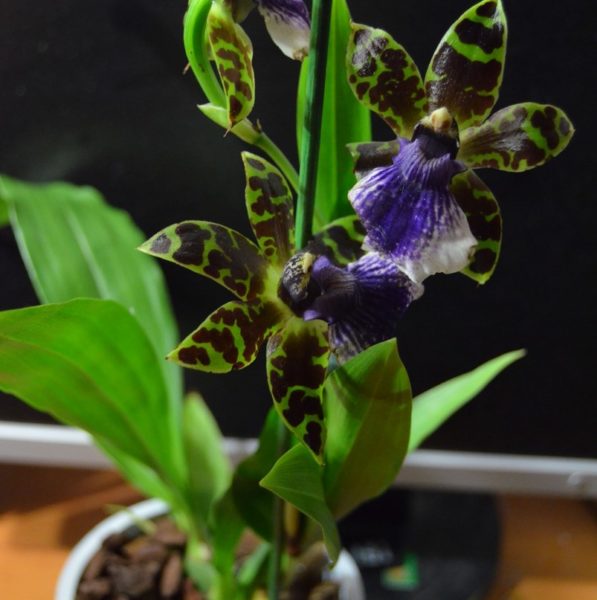
- Maxillare. It has a tall and sturdy stem reaching 35 cm in height. Most often, during the flowering season, up to eight buds can form on the stem at the same time. The petals of the bud most often have a bright burgundy or bright pink color, and the tips themselves form a green rim on the sides. The base of the bud is dark purple, with small light gaps in the middle. Stems are firm, even, without rings. The root is branched, easily adapting to life in any conditions.
- Zygopetalum blue angel. Rhein Blue Angel comes in deep blue, purple or pale blue. The stems of the Blue Rhine have rings, which characterizes the culture as a classic orchid. One of the most difficult species to care for, any damage becomes critical - the plant begins to bend, wither.The aroma is harsh, with hints of ground black pepper. The petals open up completely, which reveals a bright, dense bud and looks spectacular.
- Zygopetalum Trosi Blue. The slender and tall stem of the plant is covered with delicate transparent leaves and petals. Despite the name, Trosi Blue does not have blue flowers. Most often, the leaves are bright yellow, yellow-lilac, burgundy white and yellow-white. Possesses a delicate pleasant aroma.
- Tristy. Of all the species, it has the shortest stem - only 20 cm, half of which always sits tightly in the ground. The flowers are very large, they can reach 10 cm in diameter. The outer part is always burgundy, and the bottom has a white, lilac hue. Stems are smooth, firm, roots are branched, tangled.
- Lusendorf (in some sources Luisendorf. A flower with the most diverse possible buds - from pale blue to bright pink. Flowers are medium-sized, on a bush their number reaches 10-15 pieces, for which they are especially loved by flower growers. Stems are thin, but stable. delicate floral.
Optimal conditions of detention
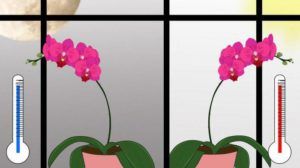 Exotic tropical plants, even hybrids, which, thanks to breeding work, are most adapted to growing at home, still feel and develop better when they are close to natural conditions.
Exotic tropical plants, even hybrids, which, thanks to breeding work, are most adapted to growing at home, still feel and develop better when they are close to natural conditions.
Therefore, the task of the grower is to provide them in the place where the phalaenopsis will please the eye.
Temperature
The most important component is to maintain a difference of 4 ° -5 ° between night and day temperatures:
- 22 ° - 24 ° C is considered optimal for full development;
- Accordingly, the night should be about 17 ° - 18 ° C.
Important! An increase to 30 ° has a negative effect on the plant, and 32 ° C is a critical temperature that can even lead to death.
The temperature should not be lower than 15 ° C.
Lighting
The place in the room or on the windowsill should be well lit with diffused light. Direct sunlight is not allowed on the orchid.
The amount of light should not be less than 10-12 hours a day. In the autumn-winter period, with a lack of light, it is necessary to connect additional lighting using phytolamps.
Humidity
Hybrids perfectly tolerate humidity at room conditions. An exception can be considered an increase in the dryness of the air in the winter, when heating devices are working. Normal indicators of humidity are considered to be 40-60%.
Stress conditions
They arise when the temperature changes from the recommended one, from damp and cold drafts, as well as during transportation during the cold season.
Reproduction and transplantation of the Zigopetalum orchid
One of the most acceptable and effective ways to reproduce the Zigopetalum orchid is to divide it into equal parts:
- The root part of the plant must be cleaned of soil substrate. Then you need to cut off the rotten dry roots.
- The flower should be divided into several parts. Each divided part of the plant should consist of 3 pseudobulbs.
- Parts, that is, shoots that have been separated from the flower, must be sprinkled with crushed coal, put in the open air and allowed to dry.
- Place the sprouts in special containers for ripening.
- The sprouts must be provided with regular watering.
- Once the sprout is ripe and good pseudobulbs appear, they will need to be placed in a pot of soil.
For planting a new plant, a substrate for adult orchids is used. Before planting, it is necessary to dry the parts of the flower intended for planting and sprinkle them with coal powder. A transplant should be carried out every 2-3 years, because this is the time during which the roots have time to grow, therefore, the plant needs a larger pot. Also, the transplant should be carried out when the substrate is depleted or infectious diseases appear.
The algorithm for transplanting is as follows:
- Moistening the soil in the pot.
- Taking out a flower.
- Cleansing the root from the old soil substrate.
- Pruning dry and damaged parts of the root.
- Removing dried stems.
- Processing and disinfection of cut sites with special means.
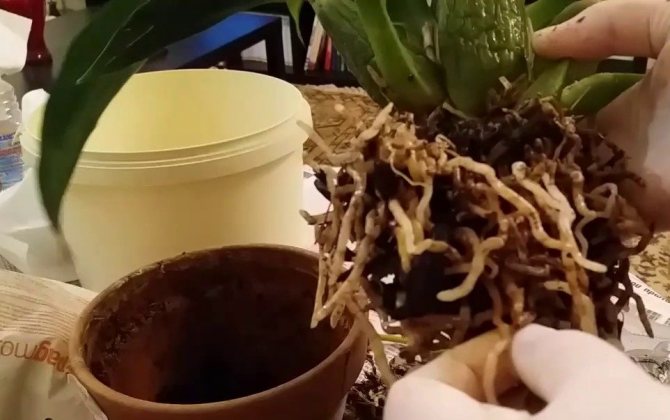
Transfer
During transplantation, it is imperative to preserve young pseudobulbs, which contain a large supply of nutrients.
Subtleties of care and maintenance
Compared to other orchids, caring for zygopetalum at home is not too difficult. But more attention is required than most common indoor flowers.
- Lighting and site selection. Not too picky about light. In nature, it grows in shaded areas, clinging to the lower branches of trees. The preferred location is west or east. They "hide" from the sun - the leaves quickly get burned. Overheating leads to premature poor flowering, slowing down the development of the orchid. The dark color of the leaves indicates full lighting, light or yellowish - about its excess.
- Temperature. Moderate warmth is needed for abundant flowering. The optimal temperature regime during the day is no more than 24 ° C, at night - about 14 ° C.
- Humidity. In the summer, an artificial increase in humidity is not required. Dry air does not interfere with the growth and flowering of the orchid. In winter, during the heating season, periodic spraying will not interfere.
- Watering. The frequency and intensity of watering depends on the season. In the phase of active growth and formation of buds, watered abundantly. Wait for the substrate to dry, but not completely dry out. Excess moisture leads to root rot and death of the plant. In the resting phase, the orchid grows pseudobulbs and roots. The need for moisture at this time is lower. Watering is moderate, accurate.
- The soil. Planted in soils for orchids. The mixture itself is made up of sphagnum, coal and bark of pine or other conifers.
- Transfer. Zygopetalum transplant is rarely performed. The flower experiences her very painfully. Indications for transplantation are pot tightness, protruding roots, transformation of the substrate into dust. Transplanting at the stage of peduncle formation is not recommended. Avoid deepening the base of the flower into the substrate.
- Top dressing. Fertilizers are applied from the moment the young shoots begin to grow until the flowers open. Preference is given to special preparations for orchids. After the end of flowering, fertilization is resumed.
Secrets of regular flowering! A prerequisite is a properly organized rest period. It begins when the plant grows up young pseudobulbs. Watering is minimized or simply sprayed over the top layer of the substrate. The flower is moved to a cool room. The optimum temperature for rest is up to 18 ° C. Permissible daily temperature drops are 4-5 ° C. The appearance of new shoots is a signal to switch to the usual mode of leaving.
Care
Caring for the zygopetalum, in principle, takes place according to the usual scheme, but in order to ensure the regular occurrence of flowers, it is necessary to take into account a special period in its cycle - dormancy. It begins when young pseudobulbs appear. Irrigation becomes minimal or is sometimes replaced by spraying surfaces from a spray bottle. The pot should be moved to a cool room, the temperature in which does not exceed 18 degrees. In principle, a drop of 4 or 5 degrees throughout the day during this period is considered normal. Dormancy ends with the emergence of new shoots.
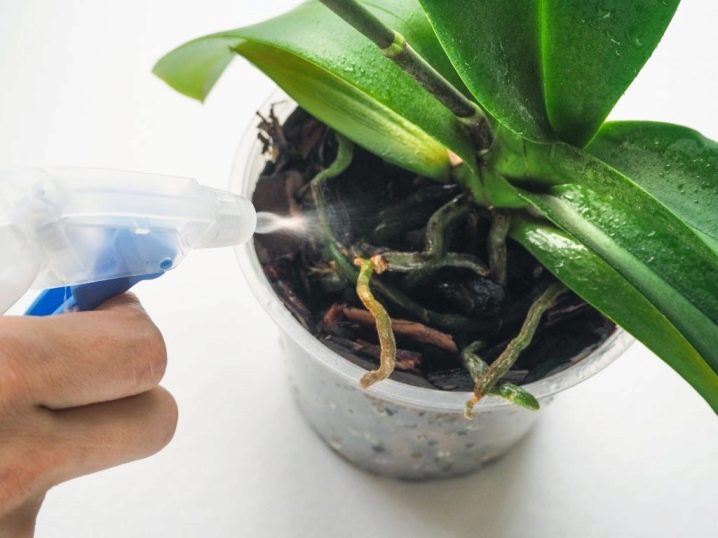
Top dressing
Fertilization occurs from the moment of active growth of the flower and until the opening of the bud. Then there is a pause during flowering, and after feeding is resumed. It is best to choose ready-made complex formulations intended for orchids, but use only half or a quarter of the dose recommended by the manufacturer. Fertilization is carried out together with water for irrigation, after which foliar spraying with the settled liquid occurs.
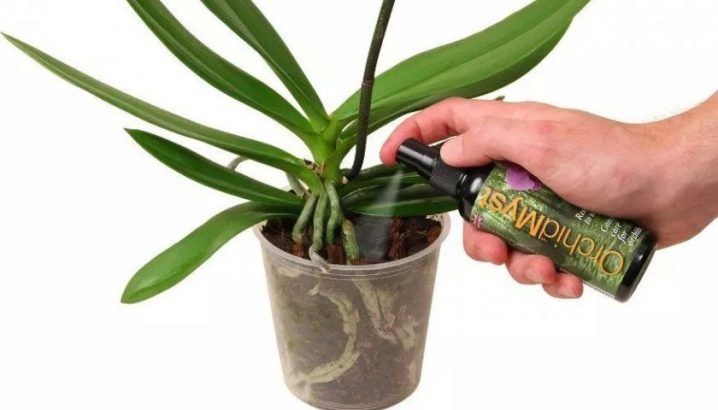
Watering
It is worth irrigating the crop in moderation and in accordance with the season and plant development cycle. For example, while the buds are still forming, and the zygopetalum itself is growing, watering should be done abundantly. Its frequency is determined based on the condition of the soil - it should dry out, but not dry out. When the orchid begins to form pseudobulbs, the amount of moisture should be reduced.
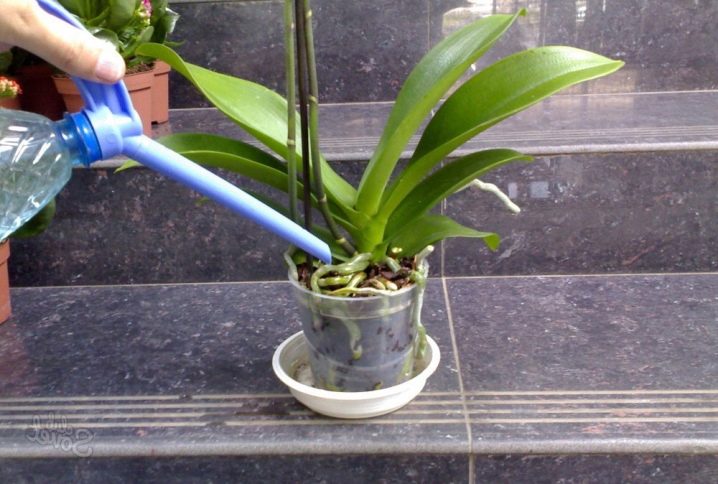
Nevertheless, overdrying the soil should also not be allowed, since the roots of the orchid cannot accumulate moisture. Fluid stagnation, in turn, leads to problems with the transport of oxygen to the root system. Ideally, watering the zygopetalum should be carried out by full immersion, when the container with the flower is immersed in the water for about a quarter or a third of an hour. Then, when the water drains, the plant returns to its habitat.

When Zygopetalum blooms
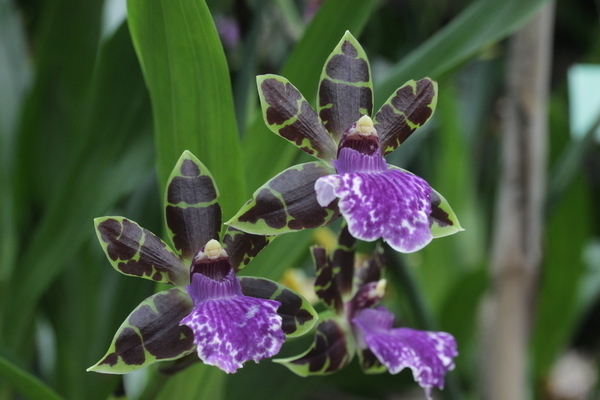
As a rule, Zygopetalum blooms in winter, however, with optimal conditions and good care, the orchid can bloom twice a year.
When young shoots appear, the development of the peduncle begins. In other words, the stem of the plant at the top passes into the stalk, on which an umbrella with flowers is located. The length of this stem is sixty to sixty-five centimeters. One inflorescence contains up to twelve flowers. Due to the complex structure of the fused petals and sepals, Zygopetalum is called “petal with petal”.
Three sepals in the orchid are obovate, two of them are located slightly lower, and the third is higher. Perianth part, lip, horseshoe-shaped with a round baggy base
She immediately draws attention to herself due to the unusual contrast. The lip is burgundy, pale pink, brown, greenish and even fuchsia
In addition, it is decorated with various stripes and spots, which are usually white. Petals are found both in plain colors and with decorations in the form of stripes and ornaments.


